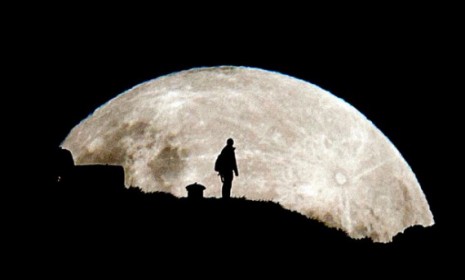Was the moon once part of Earth?
Multiple studies add credence to the theory that a piece of our planet broke off billions of years ago, thanks to a massive collision between Earth and another orb

Now that space experts have a better grasp of where the water on the moon came from, we can divert our attention to a more fundamental question: How did the moon itself even get there? Multiple studies published this week shed new light on a long-standing — but flawed — theory that the moon was birthed from a massive, high-impact collision between a primitive version of Earth and a smaller planet. Here, a concise guide to the new findings:
What happened to Earth?
There are a few competing theories with different details, but, for years, the general consensus was this: About 4.5 billion years ago a Mars-sized planet named Theia slammed into a larger "proto-Earth," says Eryn Brown at the Los Angeles Times. When Theia disintegrated, its materials were "flung asunder to form a disk around the Earth that before long coalesced to form the moon." This crash theory seemed to explain the relative sizes of the Earth and moon and their relative distance from each other. But one thing still puzzled scientists: The chemistry didn't quite match the physics... at least until now.
The Week
Escape your echo chamber. Get the facts behind the news, plus analysis from multiple perspectives.

Sign up for The Week's Free Newsletters
From our morning news briefing to a weekly Good News Newsletter, get the best of The Week delivered directly to your inbox.
From our morning news briefing to a weekly Good News Newsletter, get the best of The Week delivered directly to your inbox.
What chemical evidence is there of an interplanetary crash?
New findings reported in the journal Nature measured the amount of zinc in lunar rock samples collected by the original Apollo astronauts. It's complicated, but essentially geologists found the "ratios of heavy to light isotopes [that are] greater than on Earth," says Jesse Emspak at Space.com, suggesting the moon went through an intense evaporation period early in its formation. In other words, it means the moon's surface "was hot enough to vaporize zinc." And a high-energy, high-velocity impact is one of the few events hot enough to trigger such an evaporation period.
What else has changed in scientists' understanding of the moon's formation?
Scientists are rethinking the notion that the moon was formed primarily from materials from Theia, says Brown. "Instead, analysis showed that rock samples from the moon and Earth appeared to contain the same amounts of the same types of oxygen, titanium, silicon and other elements." The possibility that the Earth and moon were made of the same "stuff" forced scientists to theorize that part of the Earth may have broken off to become the moon as a result of the crash.
A free daily email with the biggest news stories of the day – and the best features from TheWeek.com
How plausible is this idea?
There were a few problems with this scenario, the main one being that Earth's 24-hour rotation cycle is simply too slow for an impact to break off enough material to make something like a moon. A new computer model from Harvard, however, suggests the Earth actually used to spin much faster, with a day lasting just 2 to 3 hours. "With the Earth spinning so quickly, a giant impact could have launched enough of the Earth's material to form a moon," says Britain's The Telegraph. As for the 24-hour days we have now, the gravitational pull of this newly minted moon would work in conjunction with sun over time to put the brakes on Earth's rotation, making our days what they are, well, today.
Sources: Los Angeles Times, Slashgear, Space.com, Telegraph
-
 How drones have detected a deadly threat to Arctic whales
How drones have detected a deadly threat to Arctic whalesUnder the radar Monitoring the sea in the air
-
 A running list of the US government figures Donald Trump has pardoned
A running list of the US government figures Donald Trump has pardonedin depth Clearing the slate for his favorite elected officials
-
 Ski town strikers fight rising cost of living
Ski town strikers fight rising cost of livingThe Explainer Telluride is the latest ski resort experiencing an instructor strike